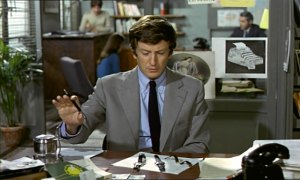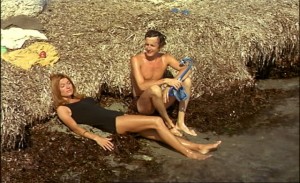Written for Kino Lorber’s Blu-Ray of the film, released on November 10, 2015. — J.R
Alain Resnais (1922-2014) was the most experimental and adventurous of all the French New Wave directors, but he has rarely been recognized as such, perhaps because he stood apart from his (mainly younger) colleagues in other respects as well. Unlike Godard, Rivette, Truffaut, Chabrol, and Rohmer, he wasn’t a critic or a writer, although as a teenager during the German Occupation of France he was already serving as a mentor to their own critical mentor, André Bazin, by introducing him to silent cinema in general and Fritz Lang in particular. He also preceded them all as a director in the eight remarkable non-fiction shorts he made between 1948 and 1958, the first of which (Van Gogh) won him his only Oscar. Indeed, the moment one compares these innovative shorts to the early sketches of Godard, Rivette, et al., the clearer it becomes that Resnais was already a courageous radical, both formally and politically, long before such a position even occurred to his colleagues. And one could argue that he was also already a film critic and film historian on his own elected turf, namely sound and image, even if he didn’t exhibit his exquisite cinematic taste in writing.
He also started out as the most international New Wave director with his first two features, Hiroshima mon amour (1959) and Last Year at Marienbad (1961), as well as his fourth and fifth, La Guerre est finie (1966) and Je t’aime, je t’aime (1968), which added Spain and Belgium to his shooting locations after Japan, Germany, and his mainly all-French third feature, Muriel (which included a 16mm amateur film supposedly shot in Algeria). But the shyness that always led him to hide behind his screenwriters, all of whom initially came from outside the film world, also tended to obscure the degree to which he remained an auteur through his intricate collaborations with them. In Je t’aime, je t’aime, this meant creating and structuring a 240-page script out of 800 or 900 pages of “automatic writing” by Belgian Surrealist Jacques Sternberg, nearly all of which consisted of short, fragmentary scenes, some of it taken directly from Sternberg’s autobiographical fiction. (According to Resnais scholar François Thomas, many of the most memorable scenes — such as Catrine’s proposal that mankind was created in order to take care of cats — and even the name of the hero, Claude Ridder, came straight out of Sternberg’s published work.) It also meant exercising a great deal of rigor over such a supposedly “free” and open structure: the film’s hero may oscillate wildly between supposedly random moments in his life over practically all of the film’s running time, but he’s filmed throughout in precisely the same manner, always located near the dead center of every frame, and nearly all the moments he relives come from the last nine years of his life.
In France, this film had the commercial misfortune of premiering the month before May 1968, when the country was hardly in the mood for cryptic internal reveries. (Even so, it had a lasting impact: Michel Gondry has admitted that it served as a major influence on his 2004 feature Eternal Sunshine of the Spotless Mind.) In the U.S. and U.K., possible misunderstandings were only compounded by the separate traditions of Anglo-American science fiction and fantasy on the one hand, and French and Belgian fantastique (and their corresponding separate traditions of anti-bourgeois and revolutionary French Surrealism and relatively conservative and bourgeois Belgian Surrealism) on the other. All this undoubtedly helps to explain why it has taken so long for the bravery and poetry of Je t’aime e t’aime to be recognized and appreciated.
The pseudo-scientific framing device of a time-travel experiment carried out with Claude Ridder (Claude Rich), a failed suicide, may suggest a rational framework, but an irrational conclusion with Ridder reappearing briefly in various spots outside the lab only confounds this notion. An earlier hint undercutting this rationalist framework occurs when Ridder suggests that the car driving him to the lab might turn into a pumpkin — and in fact, the “soft machine” chamber where he winds up reliving scattered moments of his life, after the time-travel experiment goes haywire, resembles at once the inside of a Cinderella pumpkin, a brain, a heart, an onion, and a Max Ernst canvas.
Perhaps the most serious misconception about Resnais’ work in Anglo-American criticism is the idea that his films are “cold” and/or “intellectual” (adjectives often used as if they were synonymous), which often amounts to a misreading of the French Cartesian sensibility itself. The latter’s assumption that thinking is a form of both feeling and being is countered by the more anti-intellectual bias that thinking is an alternative to feeling and/or being. Even the title Je t’aime, je t’aime might be said to refute this error. But old habits die hard, and Resnais is still viewed in some quarters as if he were one of the poker-faced, stone-hearted Flemish scientists in this film rather than a repressed romantic or a trapped mouse like Ridder himself. I can’t recall anyone ever calling the similarly experimental William Faulkner “cold” or “intellectual”, yet many of the same emotional, philosophical, and temperamental traits can be found in his own work: the tendency to hover around and over certain key moments in the past obsessively, without ever zeroing in on them, sometimes yielding a highly charged sense of stasis; abrupt temporal displacements and shifts in chronology; the mourning of lost innocence; a sense that “the past is never past” or that (as Light in August puts it), “Memory believes before knowing remembers”; giving voice to otherwise inexpressible feelings (as the all-choral score by Krzysztof Penderecki that Resnais commissioned literally does). All these traits or procedures are fully evident in Je t’aime, je t’aime — a film that, as Resnais himself pointed out, consists not of flashbacks but of moments of entrapment in a perpetual present, a very Faulknerian (as well as Proustian) register.
By his own reckoning, Resnais was an aesthete but not an intellectual, and arguably all his restless experimentation, like Faulkner’s, arose from a romantic impulse to express emotions that couldn’t be articulated otherwise by conventional means. Even the cultural references that crop up here — a cameo by Alain Robbe-Grillet, the reproduction of a nightscape by Belgian Surrealist painter Paul Delvaux in Ridder’s flat, or a plaintive Thelonious Monk track –- are emblems of mood or feeling, not intellectual signposts. As with Marienbad, Je t’aime je t’aime has been widely misread as a puzzle film that requires a skeleton key, not simply as an orchestrated work designed to be experienced and felt. The fact that every scene in the published screenplay has a precise location, date, and time — which led James Monaco, in his book on Resnais, to chart a precise chronological arrangement of over a hundred scenes that the film chose to scramble -– only clarifies the way the film was composed, not how it generates its meanings, mysteries, and emotions. Perhaps because Ridder himself returns repeatedly to uncertainties about his lover’s suicide as if trying to solve an insoluble puzzle, we may be encouraged to attack his disordered life in a similar fashion. But the film’s tragic vision ensures that we’re only taken full circle in his journey back to the suicidal gesture that led to his search—propelled, initially, by a darkly chromatic Thelonious Monk composition significantly called “Misterioso”.
I would nevertheless concede that Je t’aime je t’aime suffers from two artistic handicaps –- one of them theoretical, the other one practical. The theoretical problem is having an overall temporal structure that is meant to be both random and poetically as well as formally expressive, seemingly chaotic yet emotionally coherent in some fashion. And the practical problem, acknowledged by Resnais himself in subsequent interviews, is the casting (or, rather, miscasting) of Olga Georges-Picot as Catrine, Claude Ridder’s neurotic lover, whose death, possibly a suicide, he feels responsible for. (Among Resnais’ second choices for this part was Bulle Ogier, and it’s worth contemplating what she might have brought to this troubled and troubling character.) In contrast to Rich’s powerful performance as Ridder, Georges-Picot’s Catrine registers too often as a depressive blank.
But for better and for worse, Je t’aime je t’aime functions as a first-person narrative, even more than Resnais’ earlier Hiroshima mon amour and his later masterpiece Providence, although we may have some trouble accepting its melancholy and marginal protagonist, a sort of bureaucratic fixture whose professional identity resides in the fringes of the publishing world, as a full-fledged hero. Trapped in his own life, as we all are, and not unlike the innocent mouse who preceded him in the time-travel experiment, he can only reshuffle the same facts — or, even more tragically, can only be reshuffled by them -– as he tries helplessly to escape his destiny.










